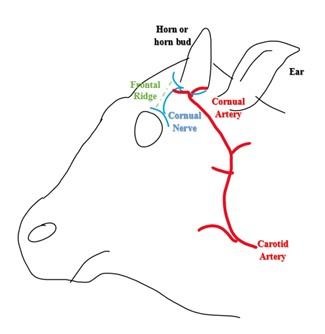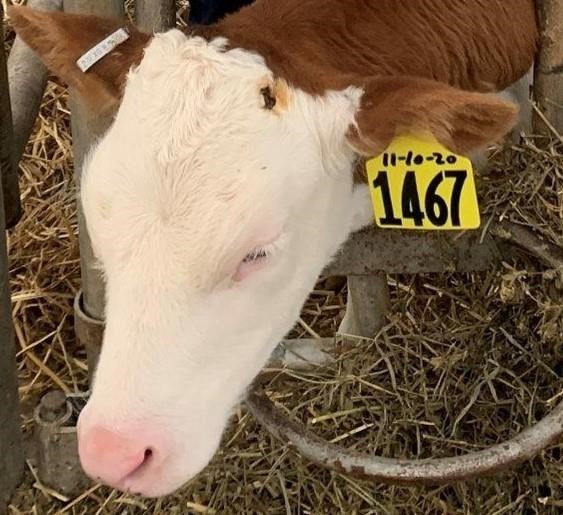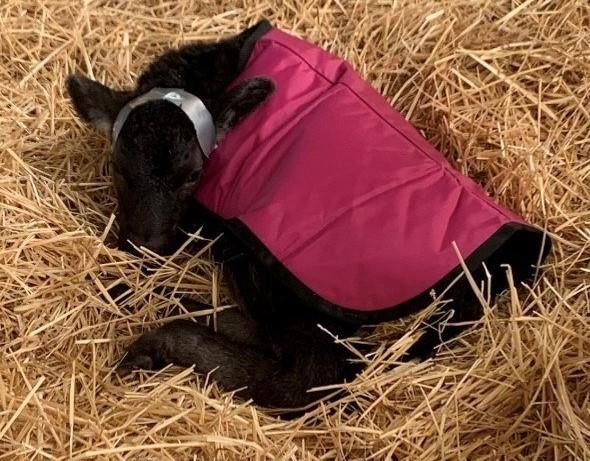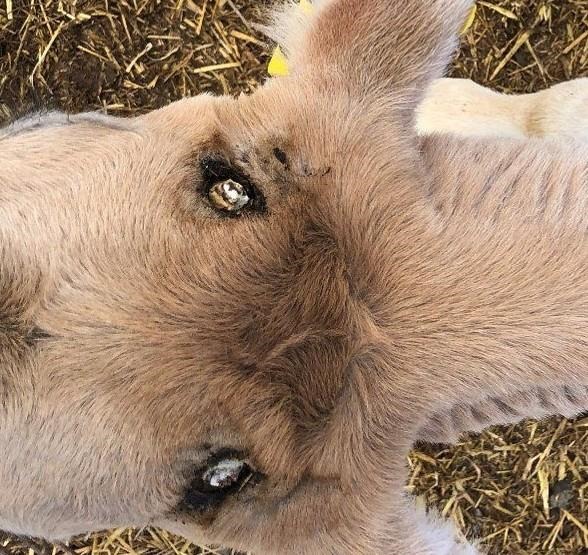To eliminate the disbudding procedure altogether, producers can select for polled genetics when breeding, resulting in a calf born with no horns. Because of selecting heavily for production traits, the dairy industry has suppressed polledness in the dairy population; therefore, selecting for polled sires in certain breeds result in inferior production traits when compared to other horned sires (Thompson et al., 2017). Including polled genetics in a breeding program is recommended to minimize the welfare, pain, and the expense associated with disbudding.
Caustic paste is one acceptable method for disbudding calves. The best time for paste disbudding is from 2 to 7 days of age. This is the stage where the horn bud is just protruding enough to be felt. The supplies needed for this method of disbudding include disposable gloves, calf halter or head restraint, hair clippers, petroleum jelly, cornual nerve block, syringes, needles, paste, vinegar, non-steroidal anti-inflammatory drugs to reduce inflammation and pain after the procedure, and possibly a calf balling gun to administer medication. The cost of this method ranges from $5.84 to $24.76 per head (Thompson et al., 2017). This cost range is attributed to the differences in paste used and pain relief provided. Below are the steps to take when disbudding with caustic paste:
- Restrain the calf’s head using a halter, chute, head gate, calf cart, etc. to minimize stress and the risk of injury to the calf and the handler.
- Clip the hair around the horn buds so they are exposed and easy to see.
- Inject a cornual nerve block on both sides of the head to reduce pain and discomfort. The cornual nerve is located halfway between the eye and the base of the horn bud and just below the bony ridge formed by the frontal bone (see image 1). The nerve block should be given about 5 to 20 minutes before the procedure. Assess the effectiveness of the nerve block by poking with a needle to see if the calf still has feeling in that area. Lidocaine is a commonly used nerve block that is available with a veterinary prescription. Be sure to clarify proper dosage and administration technique with your veterinarian before disbudding.
- Apply petroleum jelly in a ring around the horn bud to create a barrier and keep the paste only on the horn bud.
- Apply paste with gloved hands.
- To prevent the calves from rubbing up against something and smearing the paste, cover each horn bud with duct tape or vet wrap (see image 2). After applying the paste, it is best to keep calves in individual pens for at least one hour to avoid calves transferring the paste to each other. As always, keep all calves in a clean, dry area.
- If paste gets onto the skin of the handler or calf, vinegar can be used to neutralize the caustic paste.
- Researchers have found that calves experience stress and pain not only during the disbudding procedure, but also after the procedure occurs (Adcock and Tucker, 2018; Winder et al., 2018; Adcock and Tucker, 2020). In addition to a local nerve block that is only effective for about 90 minutes (Coetzee, 2013), non-steroidal anti-inflammatory drugs are recommended to reduce inflammation and pain following the procedure. Work with your veterinarian to develop an appropriate pain management protocol for your farm.
Important note: Conventional farms have many more options when it comes to pain mitigation after the disbudding procedure whereas organic dairies are limited due to regulations by the USDA and National Organic Program (NOP). Lidocaine can be used as a synthetic substance for the local nerve block in organic-certified calves but is only effective at mitigating pain during and for a short time following the procedure. Some organic producers use naturally derived therapies, such as herbal-based products but the effectiveness of these products is not thoroughly researched. All treatments used on organic farms need to first be approved by the farm’s NOP accredited agency. Working closely with a veterinarian that is familiar with organic farming practices can help organic farmers minimize the pain and stress that calves experience during the disbudding process.
Image 1. Drawing of a calf head with the cornual nerve and frontal ridge labeled in reference to the location of the eye and horn bud (Drawing recreated from University of Wisconsin-Extension).

Image 2. Calf with a red dot marking the area the local nerve block should be injected (photo credit: Carly Becker).

Image 3. A calf laying in a thick bedded pen with a strip of duct tape over her horn buds that have just been applied with caustic paste (photo credit: Carly Becker).

Hot iron disbudding is another common method used by dairy producers. If a calf is over one week of age and up to 8 weeks of age, this is the preferred method of disbudding. To emphasize what was mentioned previously in this article, according to the FARM Animal Care Manual, version 4, "any attempt to permanently remove the horn after 8 weeks of age is considered a surgical procedure and should only be performed by a licensed veterinarian." The supplies needed for this method of disbudding include a halter or other head restraint, disposable gloves, clippers, gas or electric hot iron, an extension cord and generator if not close enough to an electrical outlet (electric hot iron), butane/propane tank or cartridge (gas hot iron), cornual nerve block, syringes, needles, non-steroidal anti-inflammatory drugs, and possibly a calf balling gun to administer medication. This method of disbudding ranges from $5.78 to $23.92 per head (Thompson et al., 2017). This cost range varies due to the type of hot iron used and the pain relief provided. Below are the steps to take when disbudding calves with a hot iron:
- Preheat the hot iron and be sure to keep it away from anything flammable.
- Restrain the calf's head using a halter, chute, head gate, calf cart, etc. to minimize stress and the risk or injury to the calf and the handler.
- Clip the hair around the horn buds so they are exposed and easy to see.
- Inject a cornual nerve block on both sides of the head to reduce pain and discomfort. The cornual nerve is located halfway between the eye and the base of the horn bud and just below the bony ridge formed by the frontal bone (see image 1 above). The nerve block should be given about 5 to 20 minutes before the procedure. Assess the effectiveness of the nerve block by poking with a needle to see if the calf still has feeling in that area. Lidocaine is a commonly used nerve block that is available with a veterinary prescription. Be sure to clarify proper dosage and administration technique with your veterinarian before disbudding.
- The hot iron should have a diameter just larger than the diameter of the horn bud to cauterize the skin immediately surrounding the horn bud. Minimal pressure is needed when applying the hot iron to the horn bud area. Gently rock back and forth around the horn bud until a copper-colored ring forms around the base of the bud (about 5 to 20 seconds; see image 3). Do not leave the hot iron in one place for longer than 15 to 20 seconds. If the skin is loose or movable around the horn bud meaning that there is little chance of horn regrowth and this skin will fall off in about 3 weeks.
- Due to the pain experienced after the procedure, non-steroidal anti-inflammatory drugs are recommended to reduce inflammation and pain. Work with your veterinarian to develop an appropriate pain management protocol for your farm.
Image 4. Calf that has been disbudded with a hot iron. You can see the copper ring of the cauterized area peeking through on the right horn bud (photo credit: Cassie Yost).

All methods of disbudding and dehorning are painful for calves. By working with a veterinarian, farmers can develop an individualized disbudding protocol for their farm to help enhance animal welfare. All farm employees should be aware of the farm’s standard operating procedures to minimize pain and stress to the animals.
Source : psu.edu